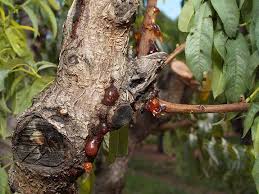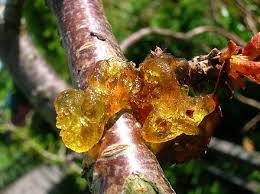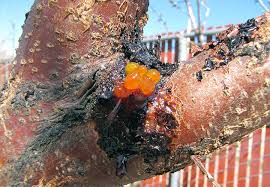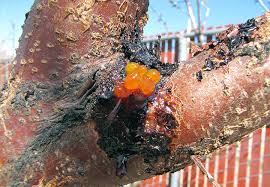Bacterial canker in stone fruit trees, scientifically known as Pseudomonas syringae pv. syringae, is a plant disease that affects various members of the Prunus genus, including cherries, peaches, plums, and apricots. This destructive infection poses a significant threat to orchards, causing damage to both fruit and tree health.
The bacterium responsible for this ailment thrives in moist conditions, making it particularly problematic in regions with high humidity or frequent rainfall. Pseudomonas syringae pv. syringae enters the tree through wounds, such as those caused by pruning, frost damage, or insect feeding. Once inside, the bacterium multiplies and spreads, leading to the characteristic symptoms of bacterial canker.
Affected trees often display dark, oozing lesions on branches, trunks, and sometimes even fruit. These cankers emit a bacterial exudate, which contains millions of bacteria, facilitating further infection and disease spread. In advanced stages, the cankers may girdle branches, restricting the flow of nutrients and water, ultimately causing dieback and decline.
Preventing bacterial canker involves implementing strict orchard management practices. Regular pruning should be performed during dry periods to minimize wounds and reduce the risk of infection. Additionally, ensuring proper spacing between trees enhances air circulation, helping to keep the environment less favorable for bacterial growth.
Fungicides and copper-based sprays are commonly employed as control measures, yet their effectiveness may vary. Early detection and removal of infected branches remain crucial in managing the disease. Prompt action can help prevent the bacterium from establishing itself within the orchard, limiting its impact on overall tree health.
However, bacterial canker poses a considerable threat to stone fruit trees, impacting both fruit production and tree vitality. Through vigilant orchard management and the timely application of preventive measures, growers can mitigate the risk of infection and safeguard the health of their orchards.
Read Also: Honey Bees: A Closer Look
Plants Affected by Bacterial Canker (Pseudomonas syringae pv. syringae)

Bacterial canker primarily affects stone fruit trees belonging to the Prunus genus. These include:
1. Cherries: Both sweet and sour cherry trees can be susceptible to bacterial canker. The disease may manifest in cankers on branches, trunks, and even fruit.
2. Peaches: Peach trees are vulnerable to bacterial canker, and infections can lead to cankers on various parts of the tree, affecting overall health.
3. Plums: Plum trees, including various varieties such as European plums and Japanese plums, are prone to bacterial canker. The disease can cause cankers on branches and trunks.
4. Apricots: Apricot trees are also at risk of bacterial canker, with the bacterium Pseudomonas syringae pv. syringae causing lesions on branches, trunks, and sometimes affecting fruit.
These stone fruit trees provide a favorable environment for the bacterium to thrive, especially when there are wounds or openings for infection. Orchard management practices and early detection play a crucial role in preventing and controlling bacterial canker in these susceptible plant species.
Damages Caused by Bacterial Canker

Bacterial canker inflicts various damages on stone fruit trees, affecting both the tree’s overall health and fruit production. The damages caused by bacterial canker include:
1. Cankers on Branches and Trunks: The most visible damage is the formation of cankers, which are dark, sunken lesions on branches and trunks. These cankers may ooze bacterial exudate, containing millions of bacteria, contributing to the spread of the disease.
2. Dieback: Advanced infections can lead to dieback of branches and shoots. Cankers that girdle branches restrict the flow of nutrients and water, causing the affected parts to wither and die.
3. Reduced Fruit Quality: Bacterial canker can directly impact fruit quality. Infected fruit may develop lesions, affecting its appearance and marketability. Additionally, the overall health of the tree influences the size and quality of the fruit produced.
4. Frost Damage Susceptibility: Trees weakened by bacterial canker become more susceptible to environmental stressors, including frost. Frost damage can exacerbate the effects of the disease and further compromise the tree’s resilience.
5. Decline in Tree Vigor: Chronic bacterial canker infections contribute to a decline in overall tree vigor. Weakened trees are more susceptible to other diseases and environmental stresses, leading to a cascading effect on the orchard’s productivity.
6. Economic Impact: The economic impact of bacterial canker is substantial, as it can result in reduced fruit yields and quality. Growers may face increased costs associated with disease management, including the application of fungicides and other control measures.
7. Risk of Orchard Spread: If left unmanaged, bacterial canker poses a risk of spreading within the orchard. Contaminated pruning tools, equipment, or even rain splashes can contribute to the dissemination of the bacterium, affecting neighboring trees.
Addressing bacterial canker promptly through preventive measures and early intervention is crucial to minimize these damages and sustain the health and productivity of stone fruit orchards.
Read Also: How Do Honey Bees Reproduce
Control and Preventive Measures

Controlling and preventing bacterial canker in stone fruit trees involves a combination of cultural practices, monitoring, and timely interventions. Here are key control and preventive measures:
1. Pruning Practices: Conduct regular pruning during dry periods to minimize the risk of wounds. Remove infected branches promptly, cutting several inches below visible symptoms. Disinfect pruning tools between cuts to prevent spreading the bacteria.
2. Orchard Sanitation: Remove and destroy any dead or infected wood from the orchard. This helps reduce the bacterial population and limits the source of new infections.
3. Proper Spacing: Ensure proper spacing between trees to improve air circulation. Adequate air movement reduces humidity around the trees, creating an environment less conducive to bacterial growth.
4. Avoiding Overhead Irrigation: Use drip or soaker hoses for irrigation to keep foliage dry. Bacterial canker thrives in wet conditions, so minimizing moisture on the leaves and branches can help prevent infection.
5. Copper-Based Sprays: Apply copper-based sprays during the dormant season as a preventive measure. These sprays can help reduce the bacterial population on the tree surfaces.
6. Fungicides: Some fungicides can provide control of bacterial canker. However, their effectiveness may vary, and it’s essential to follow recommended application schedules. Consult with local agricultural extension services for guidance on suitable fungicides.
7. Resistance Management: Planting resistant or tolerant cultivars can be an effective long-term strategy. Select varieties that have demonstrated some level of resistance to bacterial canker.
8. Monitor Weather Conditions: Be vigilant during periods of high humidity or prolonged wet weather, as these conditions favor bacterial canker development. Adjust management practices accordingly during these critical periods.
9. Early Detection: Regularly inspect trees for symptoms of bacterial canker. Early detection allows for prompt action, reducing the spread of the disease and minimizing damage.
10. Education and Training: Educate orchard workers about the signs and symptoms of bacterial canker. Training them in proper pruning techniques and sanitation practices contributes to effective disease management.
Regular monitoring and adaptability to changing conditions are essential components of a successful disease management strategy.
Frequently Asked Questions (FAQs) About Bacterial Canker (Pseudomonas syringae pv. syringae)
Q1: What is bacterial canker in stone fruit trees?
A1: Bacterial canker is a plant disease caused by the bacterium Pseudomonas syringae pv. syringae. It affects various stone fruit trees, including cherries, peaches, plums, and apricots, causing cankers on branches, trunks, and sometimes fruit.
Q2: How does bacterial canker spread?
A2: Bacterial canker spreads through rain splashes, contaminated pruning tools, and insects. The bacterium enters the tree through wounds, such as those from pruning, frost damage, or insect feeding.
Q3: What are the symptoms of bacterial canker?
A3: Symptoms include dark, sunken lesions or cankers on branches and trunks, often oozing bacterial exudate. Advanced infections can lead to dieback, impacting overall tree health. Infected fruit may also show lesions.
Q4: How can I prevent bacterial canker in my orchard?
A4: Preventive measures include proper pruning during dry periods, orchard sanitation, avoiding overhead irrigation, using copper-based sprays, and selecting resistant cultivars. Regular monitoring and early detection are crucial.
Q5: Can fungicides control bacterial canker?
A5: Some fungicides, particularly copper-based ones, can help control bacterial canker. However, their effectiveness may vary, and it’s essential to follow recommended application schedules.
Q6: Are there stone fruit tree varieties resistant to bacterial canker?
A6: Yes, some stone fruit tree varieties show varying levels of resistance to bacterial canker. Choosing resistant or tolerant cultivars can be a long-term strategy in disease management.
Q7: How does weather impact the development of bacterial canker?
A7: Bacterial canker thrives in moist conditions. High humidity and prolonged wet weather create a favorable environment for the disease. Monitoring weather conditions is essential for disease management.
Q8: What should I do if I suspect bacterial canker in my orchard?
A8: If you suspect bacterial canker, conduct a thorough inspection of your trees. Remove and destroy infected wood, apply appropriate fungicides, and consider consulting with agricultural experts for tailored advice.
Q9: Can bacterial canker spread from tree to tree?
A9: Yes, bacterial canker can spread from tree to tree. Contaminated pruning tools, rain splashes, and insects can contribute to the dissemination of the bacterium within an orchard.
Q10: How does bacterial canker impact fruit quality?
A10: Bacterial canker can directly affect fruit quality by causing lesions on the fruit. Infected fruit may have compromised appearance and reduced marketability. Overall tree health influences the size and quality of the fruit produced.
Read Also: How to Cancel a Planet Fitness Membership

